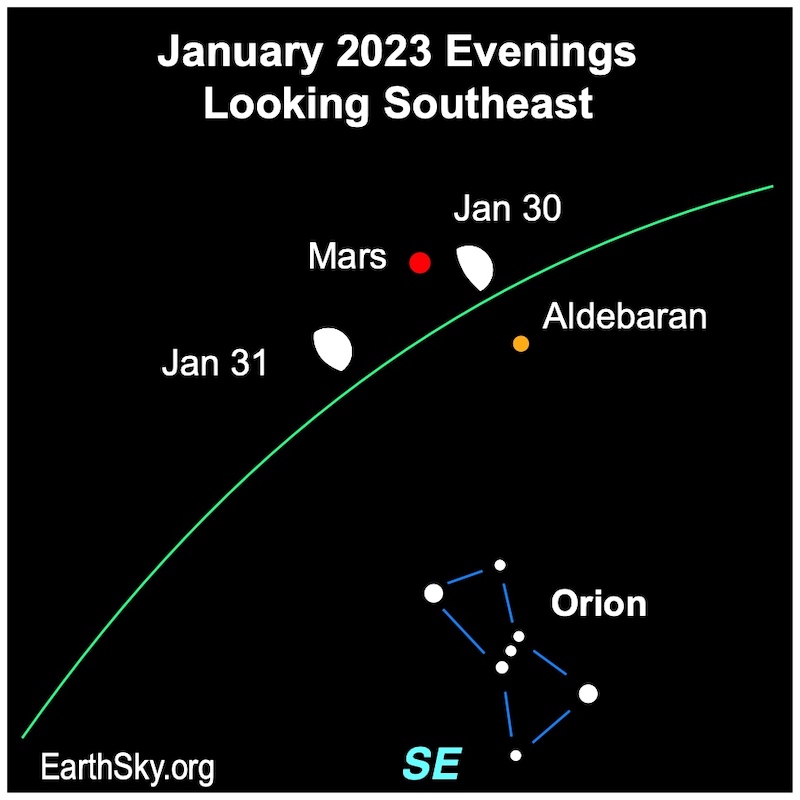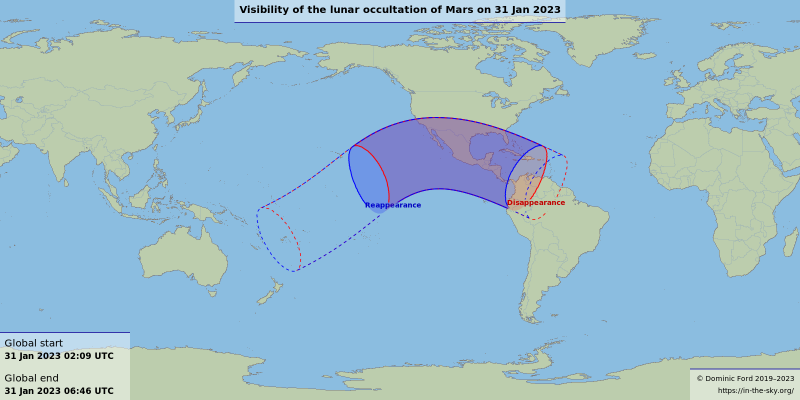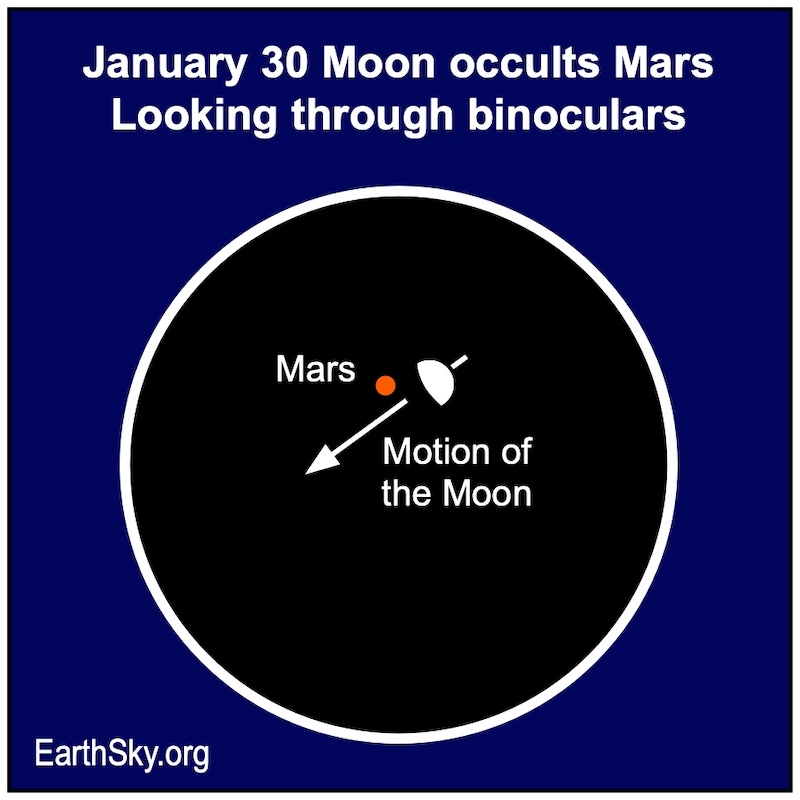
The moon occults Mars on January 30-31
Here’s hoping you have clear skies on the night of January 30-31, 2023. For all of us around the world, the waxing gibbous moon will be near bright red Mars. And, for some, the moon will slide by – and maybe even cover – Mars.
Astronomers call this event an occultation. The moon is said to occult Mars. In other words, it eclipses it, or covers it.
Can’t see Mars near the moon on the night of January 30-31? It might be because you’re looking when Mars is behind the moon. The moon and Mars will be above the horizon – for all of us around the globe – at sundown on January 30. The occultation of Mars will begin at 4 UTC on January 31 (10 p.m. CST on January 30).
The moon will pass in front of the red planet, as seen from parts of southern North America, Caribbean, northern South America and other areas, on the night of January 30-31.
The map below will let you know if your part of the world gets to view the occultation.

Who will see the moon occult Mars? And when?
If you’re in the viewing area indicated on the chart above, you’ll also need a precise time for your location. The event will happen on the evening of January 30-31 for parts of southern North America and northern South America, among a few other locations. Check out In-the-Sky.org to find the precise time Mars will disappear and reappear from wherever you are.
For those who live outside the viewing area, you’ll see the moon and Mars skim right past each other. Some places will even get to see Mars play peekaboo along the cratered and mountainous limb of the moon. And some places may see Mars as much as 2 degrees away from the moon. It’s all about location!
What will you see?
The waxing gibbous moon is bright. And it’s about 74% illuminated as seen from Earth. On the other hand, Mars is 92% illuminated, and it’s 11 arcseconds across. Also, Mars is -0.3 magnitude and the moon will be a much brighter -11 magnitude. So, can you see Mars near the moon with the eye alone the closer it gets to the moon?
Of course, you’ll see more if you use binoculars. And even more with a telescope (although the glare of the full moon will be intense through your ‘scope’s eyepiece). In fact, many regular occultation observers use telescopes.
Also, people who observe occultations typically try to catch both the disappearance and reappearance of the star or planet, as it’s blotted from view. So Mars will disappear behind the darkened edge of the moon. And then – in a while – Mars will emerge along the illuminated edge of the moon.
And, wow, what a great photo opportunity!
So what will you see of the January 30-31, 2023, occultation of Mars, if you try to watch in the sky? The answer depends on how hard you try, what tools you use, where you are on Earth – as always, on the quality of your night sky – and on your skill at observing events like this.
It’ll be a tricky observation. But many will be watching. The December 7-8, 2022, lunar occultation of Mars was well observed and recorded. Of course, Mars was brighter and larger then, but Mars is currently as bright as our brightest stars.
The binocular view

Bottom line: On the night of January 30-31, the waning gibbous moon will occult, or cover over, Mars. Details here for how to see if it’s visible from your location, and what to expect.
Read: Mars at opposition on December 7-8
The post Moon occults Mars January 30-31 first appeared on EarthSky.
from EarthSky https://ift.tt/o1d378s

The moon occults Mars on January 30-31
Here’s hoping you have clear skies on the night of January 30-31, 2023. For all of us around the world, the waxing gibbous moon will be near bright red Mars. And, for some, the moon will slide by – and maybe even cover – Mars.
Astronomers call this event an occultation. The moon is said to occult Mars. In other words, it eclipses it, or covers it.
Can’t see Mars near the moon on the night of January 30-31? It might be because you’re looking when Mars is behind the moon. The moon and Mars will be above the horizon – for all of us around the globe – at sundown on January 30. The occultation of Mars will begin at 4 UTC on January 31 (10 p.m. CST on January 30).
The moon will pass in front of the red planet, as seen from parts of southern North America, Caribbean, northern South America and other areas, on the night of January 30-31.
The map below will let you know if your part of the world gets to view the occultation.

Who will see the moon occult Mars? And when?
If you’re in the viewing area indicated on the chart above, you’ll also need a precise time for your location. The event will happen on the evening of January 30-31 for parts of southern North America and northern South America, among a few other locations. Check out In-the-Sky.org to find the precise time Mars will disappear and reappear from wherever you are.
For those who live outside the viewing area, you’ll see the moon and Mars skim right past each other. Some places will even get to see Mars play peekaboo along the cratered and mountainous limb of the moon. And some places may see Mars as much as 2 degrees away from the moon. It’s all about location!
What will you see?
The waxing gibbous moon is bright. And it’s about 74% illuminated as seen from Earth. On the other hand, Mars is 92% illuminated, and it’s 11 arcseconds across. Also, Mars is -0.3 magnitude and the moon will be a much brighter -11 magnitude. So, can you see Mars near the moon with the eye alone the closer it gets to the moon?
Of course, you’ll see more if you use binoculars. And even more with a telescope (although the glare of the full moon will be intense through your ‘scope’s eyepiece). In fact, many regular occultation observers use telescopes.
Also, people who observe occultations typically try to catch both the disappearance and reappearance of the star or planet, as it’s blotted from view. So Mars will disappear behind the darkened edge of the moon. And then – in a while – Mars will emerge along the illuminated edge of the moon.
And, wow, what a great photo opportunity!
So what will you see of the January 30-31, 2023, occultation of Mars, if you try to watch in the sky? The answer depends on how hard you try, what tools you use, where you are on Earth – as always, on the quality of your night sky – and on your skill at observing events like this.
It’ll be a tricky observation. But many will be watching. The December 7-8, 2022, lunar occultation of Mars was well observed and recorded. Of course, Mars was brighter and larger then, but Mars is currently as bright as our brightest stars.
The binocular view

Bottom line: On the night of January 30-31, the waning gibbous moon will occult, or cover over, Mars. Details here for how to see if it’s visible from your location, and what to expect.
Read: Mars at opposition on December 7-8
The post Moon occults Mars January 30-31 first appeared on EarthSky.
from EarthSky https://ift.tt/o1d378s

Aucun commentaire:
Enregistrer un commentaire